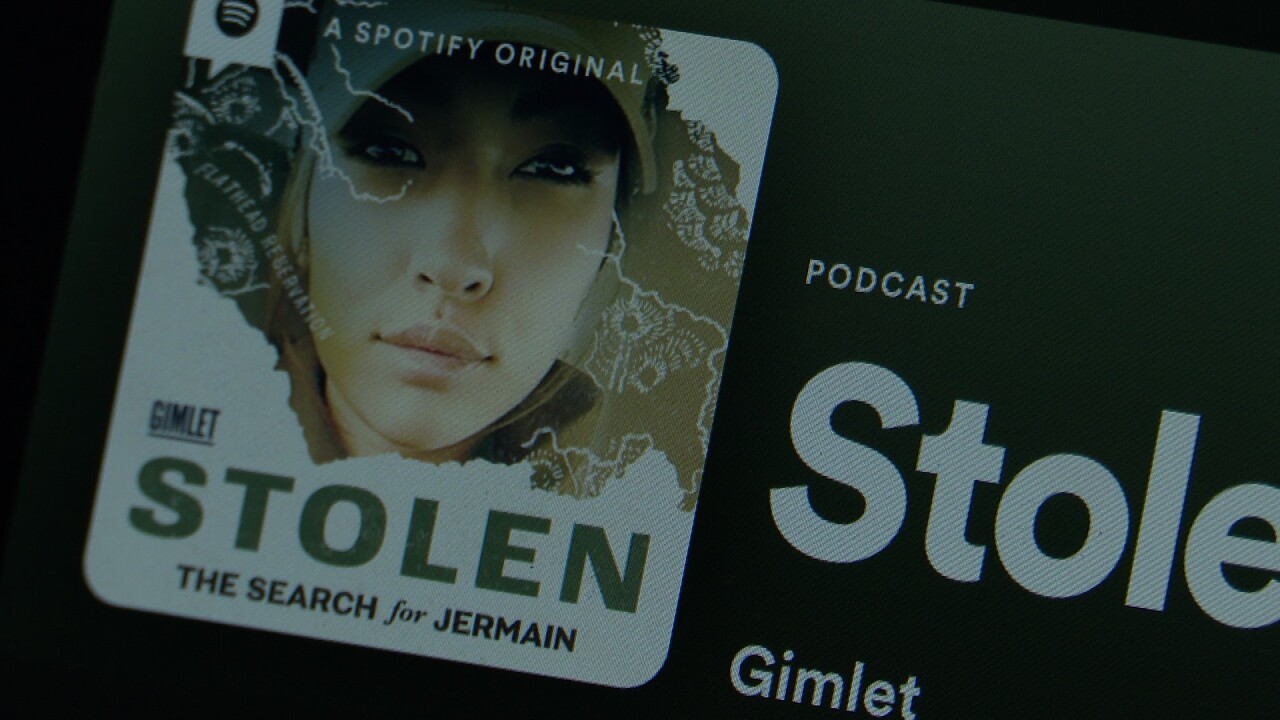MISSOULA — This week marks the three year anniversary of Jermain Charlo's disappearance.
The 23-year-old mother from Dixon Agency has become a well-known face in the Missing and Murdered Indigenous Persons (MMIP) crisis in Montana -- and now worldwide.
MTN News first reported the disappearance of Jermain in the summer of 2018. Three years later, her case has not seen any closure.
Here’s a breakdown of some of the key dates from her disappearance:
- June 15, 2018: Jermain was seen at the Badlander bar in downtown Missoula. Just after midnight, a Missoula Housing Authority camera recorded her walking out of the alley behind the Badlander bar. This is the last known visual of Jermain alive.
- The following day, June 16, Jermain’s reported last location was the Orange Street Food Farm where she was allegedly dropped off. Multiple searches were held in the area.
However, in the podcast "Stolen: The Search for Jermain Charlo", Missoula Police Detective Guy Baker told podcast producer Connie Walker that Jermain was actually dropped off near the intersection of Prince and South Fifth Street West -- eight blocks away from the Orange Street Food Farm.
During a protest in March of 2021, MTN News viewed a 2018 search warrant which showed Jermain’s cell phone was active near Evaro until 10 a.m. the day of her disappearance, June 16.
MTN News sat down with Detective Baker for his reflection on the past three years of Jermain's case, which remains an active investigation. "So it's not a closed case, it's not a cold case. It’s still very active,” Baker told MTN News.
He's is the second detective to be in charge of the case; eleven days after Jermain was last seen on an unreleased Missoula Housing Authority video, Baker was reassigned to the case and now works to solve it.
Baker said he continues to stay in touch with Jermain’s family to keep them in the loop, but many caveats of his research are unreleased to protect the investigation’s integrity. He stands by his work for Jermain, who he says is the only Native American woman being worked as missing in Missoula.

“I think you always look to the past to see if you can do better. You know you try to do the best job you can under the circumstances, but, you know, looking back some things could have been done a little differently that I think would have been beneficial, but nothing was done wrong -- or was detrimental I should say -- to the investigation,” Baker explained.
Media undoubtedly plays a role here. Gimlet Media, a division of Spotify, released a podcast documenting Jermain's case this year. Baker is prominently featured in the reporting.
“An issue that comes up between the public and law enforcement is perception. And what everyone's perception is to them is reality, when in fact, it may not be actual reality. So, the podcast was not entirely accurate. So, people have listened to that, and they have drawn some conclusions that might not be entirely correct,” Baker said.
Baker said sometimes the police are not in a position to correct the record as that could jeopardize an investigation, and would not clarify what those facts were.

Last year, journalist Connie Walker was on the ground in Missoula doing her own investigation. “There's never been a request for the Missoula Police Department or Guy Baker to correct anything in our podcast,” Walker said.
Walker, an Indigenous Cree woman from Canada, documented the case in the eight-episode “Stolen: The Search for Jermain.” She studied Jermain’s past and spoke with family, friends, and Detective Baker.
“I've actually been hearing from so many people in and around Missoula, who knew of Jermain -- or knew people in the podcast," Walked said. "And I'm continuing to have those conversations. I am really hoping to do more reporting on Jermain’s case as soon as we can."
Since the podcast's final episode release, it has reached an international level, resonating with Indigenous communities primarily but also those unaware of the MMIP issue.
“This crisis of violence that so many Indigenous women and girls face, and men and boys in Canada and in the United States,” Walker explained.

To Walker, her work isn’t just a job. Her own Indigenous community also experiences a height of violence.
“Getting to learn about Jermain’s life through her family and friends, has been such a privilege and an honor, and I treat it as a responsibility,” Walker said.
Something echoed between Walker and Baker -- more information is out there.
“For all of the reporting that we've been able to do obviously it's great to raise awareness about Jermain’s case on a national level or international level, but I think that it's particularly important that people there in her community are also paying attention, and know the story of, Jermain’s story, and that her disappearance is still unsolved,” Walker said.
These sources want to make clear that Jermain Charlo is not just a face on a billboard. Anyone with information about the case should contact local law enforcement or Detective Baker at (406) 552-6284.
Since Jermain’s disappearance in 2018, a number of resources and guidelines have been generated to address the MMIP crisis.
Montana’s Missing Indigenous Persons Task Force was created in 2019 to help administer grant money and improve interagency collaboration and last October, Blackfeet Community College launched a website meant to streamline the process of reporting a missing person on the Blackfeet Nation. CSKT joined the portal last month.
Meanwhile, the Snowbird Fund became available in February to financially help Native American families search for their missing loved ones. And in April, CSKT completed the nation’s first Tribal Community Response Plan - a coordinated effort meant to serve as a guide in Indigenous communities when responding to a report of a missing person.




